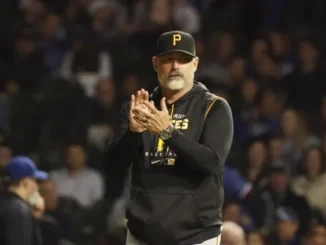The Atlanta Braves are blessed with one of the best strikeout artists operating in MLB today
The Atlanta Braves are not resting on their laurels following their impressive 2023 season. Despite the outstanding offensive performance last year, President of Baseball Operations Alex Anthopoulos has been actively pursuing improvements through the trade market. Notably, he secured Jarred Kelenic as the everyday starter in left field and brought in Chris Sale to strengthen the rotation.
The current rotation is embracing Anthopoulos’ commitment to enhancement, with potential upgrades in the works. Spencer Strider, speaking at the recent Braves Fest, hinted at refining his already formidable fastball/slider arsenal. Strider acknowledged that while he has thrown the changeup throughout his career, he has realized its mechanical challenges. Exploring his body, biomechanics, and strengths and weaknesses, he expressed that the changeup may not be an easy pitch for him to execute consistently. Strider suggested that he might focus on learning other pitches with a higher aptitude, indicating a potential shift in his approach.
During the 2023 season, Strider increased the usage of his changeup to 7.3% of his pitches. Despite its limited usage, the pitch proved effective with a low .122 batting average allowed and a positive +2 run value (74th percentile), according to MLB Statcast.
However, as Strider hinted, some pitchers find the changeup challenging to execute. Given that Strider primarily throws a four-seam fastball, designed to resist gravity as it approaches the top of the zone, he ideally seeks a changeup with more vertical drop, known as “sink,” rather than armside movement, referred to as “run.” Achieving maximum effectiveness in this pairing requires pronating the hand, rotating it and the forearm to face downward upon release. This imparts spin, causing the desired downward movement and reducing velocity. Executing this while maintaining the same arm speed as a fastball is no easy feat, and the changeup is often considered a “feel” pitch for this reason.
Most pitchers have a preference for pronation, supination, or backspin, and Strider does not favor supination. (Supination involves rotating the hand and forearm so that they both face upward at release.) Strider admitted that his previous attempts with a curveball were unsuccessful, mainly due to his limited ability to supinate well.
“I had to really hook it and try to get it over the top and roll out, so it didn’t have any velocity,” Strider explained to The Athletic’s Eno Sarris back in May. “I was inducing a lot of movement, but it wasn’t tunneling at that point.” Consequently, the switch to a more robust breaking ball, a slider, enabled Strider to achieve negative movement on the pitch and maintain the tunnel, or identical flight, with the fastball and slider during the initial part of the pitch’s trajectory.
Strider’s inherent movement patterns, referred to as “motor preferences,” do not align well with the required actions for throwing curveballs and changeups. Such disparities are not uncommon.
Nevertheless, Strider emphasized that he wouldn’t adopt any new pitch casually; it had to be a quality addition. While he acknowledged the conventional wisdom that more pitches can make a pitcher harder to hit, he personally didn’t find it to be a universal truth. For him, success hinges on timing—making it challenging for batters to react, especially when they must respect the fastball. Execution, according to Strider, is paramount, and he admitted that deviating from his fastball/slider combination occasionally led to difficulties.
In Strider’s perspective, it makes more sense to stick with the primary fastball/slider duo, particularly when they rank among the top individual pitches in baseball. He prefers maintaining the excellence of those two pitches rather than introducing a potentially inferior third pitch, like the changeup, into the mix.
What pitch could Strider look to add?
Considering Strider’s inability to supinate, adding a sweeper to his repertoire appears to be the most feasible option, given its relatively uncomplicated mechanics. However, it’s essential to note that the sweeper, despite its popularity in the previous season, is not a universal solution. It exhibits significant platoon splits, primarily due to its pronounced movement toward the glove side. Unless effectively located inside against opposite-handed batters, it may not prove as effective.
Another potential addition could be a two-seam fastball. Strider currently uses a changeup infrequently, appreciating not only the velocity difference but also the unique movement it offers. Desiring a slower pitch with more horizontal movement to his arm side, a two-seamer might fit the bill. While inherently faster than a changeup, it shares the benefit of disrupting the hitter’s “sight picture” by introducing variation in pitch location. This strategy aims to challenge hitters who have been anticipating fastballs up and sliders down during the at-bat.
Strider highlighted this point, stating, “You throw one fastball down, all of a sudden they have to think about that. Even if they are sitting on the fastball up, their brain cannot process 98 mph with 20 vertical inches of movement and still be on time every time and get the barrel to the ball, especially anyone that has a launch angle swing.”
Considering Strider’s natural backspin motor preference, there’s also the consideration of incorporating a splitter. The low-spin nature of a splitter often mitigates the vertical movement that a backspin pitcher may struggle to eliminate naturally with a standard changeup. This alignment with his natural tendencies makes the splitter a potential fit for Strider’s repertoire.
No new pitches yet
At present, Strider finds success with his effective fastball and slider combination, and the need for a third pitch doesn’t arise frequently. However, when the time comes to incorporate a third pitch, it won’t be as straightforward as selecting one based solely on compatibility with Strider’s movement patterns. Lance Brozdowski, a player development analyst for Marquee Network known for detailed pitching analyses on his YouTube channel, suggests a more nuanced approach for Strider.
Brozdowski emphasizes the importance of defining the purpose of the new pitch. Adding a pitch just for the sake of having one may not yield significant benefits, but if Strider has a specific goal in mind, he can select a pitch tailored to that scenario and adjust other elements of his arsenal accordingly.
For example, incorporating a sweeper would require modifying Strider’s existing gyro slider to reduce horizontal movement, transforming it into a more distinct vertical breaking pitch.
Regardless, there are currently no glaring deficiencies in Strider’s arsenal. His existing pitches are highly effective, and any improvements would likely involve refining the already-existing changeup. While Strider may express skepticism about this potential adjustment, it’s worth considering that opinions can evolve, and there’s value in forward-thinking and exploration.



Be the first to comment